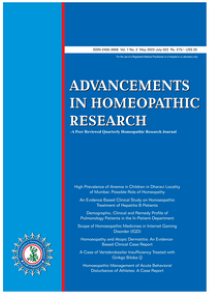Therapeutic Effect of Homoeopathic Mother Tincture of Abroma Augusta (R) on Glycosylated Haemoglobin (HbA1c) Level in Type2 Diabetes Mellitus (T‚ DM) Patients
Keywords:
Diabetes Mellitus Type 2, HbA1c, FBS, PPBS, Abroma Augusta rAbstract
Background: Type 2 diabetes mellitus (T‚ DM) accounts for 90% of cases of diabetes globally. Studies have suggested that Abroma Augusta plays a role in short term control of blood glucose level. The present study evaluates the effect of “AbromaAugusta r” in long term control through GlycatedHb (HbA1c %) in T‚ DM
Objective: The primary objective is to evaluate the changes in the HbA1c level in T‚ DM patient after the intervention of “Abroma Augusta r”. The secondary objective is to evaluate the changes in Fasting Blood sugar (FBS) and the Post prandial blood sugar (PPBS) level to compare the short term control and long term control.
Material and methods: Thirty one subjects of T‚ DM were included in the study based on purposive sampling technique following inclusion and exclusion criteria. This was pretest post-test study of HbA1c% on Type 2 Diabetic patient’s for a period of 4 months, along with monthlyFBS & PPBS level. Intervention of Abroma Augusta r was made following Homoeopathic principle. Each subject was given Abroma Augusta r 30 drops TDS for the period of 4 months.The data was statistically analyzed using paired‘t’ test, ANOVA &Bonferroni test for the analysis of variants.
Result:Every patient showed the significant
improvements in HbA1c%, FBS & PPBS. The‘t’ value of statistical analysis of HbA1c% is 8.295which is more than Tabled value, ANOVA test for FBS& PPBS show highly significant as p<0.001. Bonferronitest for FBS & PPBS also show highly significant as p<0.01.
Conclusion:A statistically significant decline inFBS, PPBS and HbA1c level indicates that the Abroma Augusta Q has the potentiality to control FBS PPBS & HbA1c.




